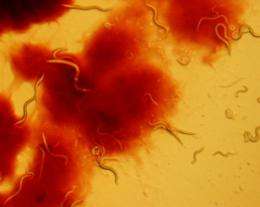Sexual reproduction works thanks to ever-evolving host, parasite relationships: study

(PhysOrg.com) -- It seems we may have parasites to thank for the existence of sex as we know it. Indiana University biologists have found that, although sexual reproduction between two individuals is costly from an evolutionary perspective, it is favored over self-fertilization in the presence of coevolving parasites. Sex allows parents to produce offspring that are more resistant to the parasites, while self-fertilization dooms populations to extinction at the hands of their biological enemies.
The July 8 report in Science, "Running with the Red Queen: Host-Parasite Coevolution Selects for Biparental Sex," affirms the Red Queen hypothesis, an evolutionary theory who's name comes from Lewis Carroll's Alice in Wonderland text: "It takes all the running you can do, to keep in the same place." The idea is that sexual reproduction via cross-fertilization keeps host populations one evolutionary step ahead of the parasites, which are coevolving to infect them. It is within this coevolutionary context that both hosts and parasites are running (evolving) as fast as they can just to stay in the same place.
"The widespread existence of sex has been a major problem for evolutionary biology since the time of Charles Darwin," said lead author Levi T. Morran. Sex does not make evolutionary sense, because it often involves the production of males. This is very inefficient, because males don't directly produce any offspring. Self-fertilization is a far more efficient means of reproduction, and as such, evolutionary theory predicts that self-fertilization should be widespread in nature and sex should be rare. However, as we all know, this is not the case.
The Red Queen Hypothesis provides one possible explanation for the existence of sex.
"The Red Queen Hypothesis predicts that sex should allow hosts to evade infection from their parasites, whereas self-fertilization may increase the risk of infection," said co-author Curtis M. Lively.
By combining the DNA of two parents, sex allows parents to produce offspring that are genetically diverse and different from their parents. Parasites that have adapted to infect one generation may have difficulty infecting the next generation. However, offspring produced through self-fertilization inherit the DNA of their single parent, thus any parasites adapted to infect the parent should also be capable of infecting the offspring.
Morran, a post-doctoral researcher, and Lively, a distinguished professor of biology, both in the IU Bloomington College of Arts and Science's Department of Biology, authored the report with biology undergraduates Olivia G. Schmidt, Ian A. Gelarden and Raymond C. Parrish II.
The team used the microscopic roundworm Caenorhabditis elegans as a host and the pathogenic bacteria Serratia marcescens to generate a host-parasite coevolutionary system in a controlled environment, allowing them to conduct more than 70 evolution experiments testing the Red Queen Hypothesis. They genetically manipulated the mating system of C. elegans, causing populations to mate either sexually, by self-fertilization, or a mixture of both within the same population. Then they exposed those populations to the S. marcescens parasite. The parasites were either allowed to coevolve with C. elegans or were prevented from evolving. The researchers then determined which mating system gave populations an evolutionary advantage.
"We found that the self-fertilizing populations of C. elegans were rapidly driven extinct by the coevolving parasites, a result consistent with the Red Queen Hypothesis," Morran said. On the other hand, sex allowed populations to keep pace with their parasites. "Sex helped populations adapt to their coevolving parasites, allowing parents to produce offspring that were resistant to infection and ultimately avoid extinction," he noted.
In host populations where either sex or self-fertilization were possible, the evolutionary state of the parasite determined the most effective reproductive strategy. When the parasite did not coevolve, self-fertilization evolved as the dominant form of host reproduction. However, when the parasite was allowed to coevolve with the hosts, then sex became the favored reproductive strategy.
"Coevolution with the pathogen not only favored sex over self-fertilization, but also allowed sex to be maintained throughout the experiment," Morran said.
These results are consistent with the Red Queen Hypothesis and may go a long way toward explaining the widespread existence of sex.
"Coevolving parasites seem to be very common in nature," said Lively. "The experiment shows that coevolution with parasites, but not the presence of parasites per se, selects for higher levels of outcrossing. Thus the coevolutionary struggle between hosts and their parasites could explain the existence of males."
More information: "Running with the Red Queen: Host-Parasite Coevolution Selects for Biparental Sex," Science, July 8, 2011, Manuscript #: science.1206360, by: L.T. Morran; O.G. Schmidt; I.A. Gelarden; R.C. Parrish II; C.M. Lively, Indiana University.
Provided by Indiana University



















